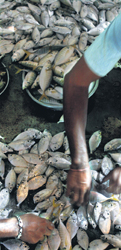|
|
|||||||||||||||||||||||||||||||||||||||||
|
Soaring prices, sinking fishermen The tsunami, rising oil prices and fewer fish drown the fishing industry
Stopped by the fish market recently? If you have, like most consumers, you would have most likely been shocked by the prices of fish which have soared in recent months, making many cut back drastically on their consumption.
The rising prices have also affected the fishing community, hard hit by the tsunami, at a time when it was just struggling to re-establish its livelihood.
“Now very few people are buying a kilo of fish. Everything has gone up and we don’t know how to get people to buy fish to continue our business,” said 29-year-old S. Janaka, who has been selling fish at the Hendala market for nearly 10 years. The industry worst affected by the tsunami, almost the entire fishing community lost its livelihood to the waves. “The tsunami not only took our boats, but also the fish in the sea. Now there is less fish in the waters and as a result, the catch is less. So we have to sell the fish we get for high prices,” Janaka said.
Suranga Pradeep, who owns a fish stall in Hendala lays the blame for the current price increase on the oil price hike. “I have five boats, but now I only take out one as I don’t have money for the fuel. We have to spend Rs. 2,000-3,000 for fuel per day and we are only earning a little more than a thousand rupees from selling fish. What’s the point in using more boats when we can’t make a profit,” he asked.
Ranjith Silva, was unravelling his fishing net and picking out the fish one by one when we caught up with him. “I have been in this business for nearly two decades, and it is only now that I am seeing less fish in the water. Those days, the net would be full of entangled fishes, but now it’s mostly empty,” he said.
“It’s expensive even here. I used to buy fish every other day, but I will have to cut down from now on, no matter how nutritious it is,” said Ajith Priyanka, a resident of Kandana who had come all the way to Hendala in the hope of getting fish at a cheaper price. S.P. Felix, a father of four, said although his children love to eat fish, he only buys fish once or twice a week. “Fish is good for growing children, but what to do? If the prices increase further we will be forced to cut down,” he said. At Fresh Fish in Colombo 4, where many walk in to buy their weekly requirements of fish, it was a similar story of high prices and less sales. “Earlier, people would come in and buy at least three kilos to keep for many days. But now, the average customer comes only to buy a day’s need, which is less than a kilo. As a result, we only bring few fish varieties when compared to earlier times,” said Manager H.D. Gunasekara. S.Nagarani, who shops at the St. John’s market in Pettah said her family is fast on the way to becoming vegetarians as a result of the increased price of fish. “We don’t eat meat or chicken, and now we cannot even buy fish for a reasonable price,” she said. “Usually on Saturdays or Sundays, we have
customers, especially those from the upper class and restaurateurs.
But on other days, we get fewer people coming in and it’s
affecting our day-to-day income in a big way,” said H.P. Lalith,
who has been working at the Kollupitiya fish market for nearly 30
years. P.K.R. Sami, who has been selling fish in the St. John’s market for nearly four decades, said the current northeast situation was also affecting the fisheries sector. “We are not getting fish from the North and the East due to the crisis there. That’s one of the reasons for the supply being reduced. As people are not buying because prices are high, we are getting very little income these days,” he said. Assistant Director of the Fisheries Department in the East, George Domingo while agreeing that the northeast problem was one of the main reasons for the hike in prices, added there were other issues affecting the fishing industry. “Donors and other NGOs grant relief sometimes to the non-affected fishermen without consulting the Fisheries Department. This is having an adverse impact, as the affected fishermen are looking for other livelihood options,” he said. “Cash for Work Programmes started by the NGOs to grant monetary facilities to the tsunami-affected, have attracted fishermen as they are getting money doing other jobs. These occupations look more attractive to them as they could earn money without the fear of not getting any catch or the risks involved like rough seas,” Mr. Domingo said. Has the fact that many tsunami affected fishermen still haven’t got new boats contributed to the current high prices of fish? Director of the Department of Fisheries, G. Piyasena said that 95% per cent of the affected people have received coastal fisheries boats. However, the offshore and deep-sea fishing crafts have not been replaced fully, he admits. “When we talk of the offshore and the deep-sea fishing vessels, it is mainly the multi-day boats and bigger boats. The tsunami destroyed nearly 200 multi-day boats, out of which nearly 30 were replaced. These boats cannot be replaced that quickly due to their high cost. But most of the fishermen in Sri Lanka fall into the category of coastal fisheries,” he said. While the Government is trying to work out the problems hindering the fisheries industry, how long does the consumer have to wait till the price of fish comes down? “Towards October, the southern coast will have its fish season and then there will be a huge catch. There will be more fish in the market and the price will decline,” said Mr. Piyasena. Consumers can only hope his predictions will be proved correct.
* Prices in LKR. | |||||||||||||||||||||||||||||||||||||||||
Copyright © 2006 Wijeya Newspapers
Ltd. All rights reserved. |
|||||||||||||||||||||||||||||||||||||||||



